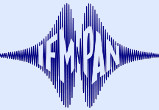SUMMARY REPORT
on the activity in the Centre of Excellence for Magnetic and Molecular Materials for Future Electronics at the Institute of Molecular Physics, Polish Academy of Sciences in Poznań
Centre of Excellence for Magnetic and Molecular Materials for Future Electronics (acronym MMMFE) operated from December 1, 2002 to November 30, 2005 at the Institute of Molecular Physics, Polish Academy of Sciences in Poznań, Poland. Its purpose was to extend research in solid state physics of new materials in areas of recognized importance for future applications in novel electronics, in particular, in spin-dependent transport in nanostructured and layered systems as well as new magnetic materials for magnetoelectronics; in the design of new organic low-dimensional and molecular materials as well as the search for new molecular electronic devices, and studies of ferroelectric polymers, electroactive ceramic-polymer composites and liquid crystals for modern sensor and actuator applications. The strategic aspects of MMMFE included:
- search for future applications in electronics,
- international research and organization of scientific meetings,
- education and promotion of young physicists.
The activity of the Centre was based on a jointly executed programme
consisting of six workpackages (WP):
WP1 - Nanostructures for Magnetoelectronics, led by S. Krompiewski;
WP2 - Enhancing Experimental and Theoretical Efforts in Search for New
Magnetic Materials, leader: A. Jezierski
WP3 - Molecular and Nanostructured Materials for Advanced Applications:
Physics and Engineering, leader: R. Świetlik;
WP4 - Dielectric Materials for Advanced Technology, leader: B. Hilczer,
WP5 - Liquid-Crystalline Materials For Advanced Technology, leader: W.
Kuczyński,
WP6 - Auxetics and related materials, leader: K. W. Wojciechowski.
All the workpackages contain tasks for enhancement of co-operation and
integration with European Research Area. The works of the Centre were
coordinated by B. Bułka and J. Tritt-Goc.
In the Centre we carried out advanced research on physics of magnetic and molecular materials for the novel electronics. Many interesting results were obtained in modelling of electronic transport through nanostructures and molecular devices. During the studies of magnetic and molecular materials for nanoelectronics, new effects in liquid crystals were discovered. The results were published in 104 papers (many in co-operation with partners from Europe).
Our main task was to organize seven scientific meetings:
- School on New Magnetics, September 15-19, 2003;
- School on Nanostructured Systems: Basic Properties and Technology, May 31-June 2, 2004;
- Conference on New Concepts And Materials, September 11-15, 2004;
- School on Polymers and Composites, May 9-13, 2004;
- Workshop on Auxetics and Other Materials, June 27-30, 2004;
- Conference RAMIS-2005, April 24-28, 2005;
- School on Chiral Liquid Crystals, May 22-26, 2005.
The meetings gathered more than 400 participants, the proceedings were published in the following journals: Molecular Physics Reports, Materials Science, Computational Methods in Science and Technology, physica status solidi (b), Acta Physica Polonica A and in the book "Chiral Liquid Crystals", ed.: W. Kuczyński (all the materials are available at web page of the Centre). Moreover, we organized: i) the Workshop on Band Structure and Spectra Calculations by SPR-KKR Method, September 22-24, 2003; and co-organized ii) European Conference Physics of Magnetism'05, June 24-27, 2005.
Expansion and intensification of our links with European Research Area was an important objective, which was achieved through the exchange of the research staff, teachers and students. In the three year period we had in the Centre 32 visitors from different European countries. 56 scientists from the MMMFE visited different European research laboratories. The main results of these visits are: training young researchers, creation of common European projects, new collaborations and experiments performed on unique equipments not available in our institute, common papers, transfer of new technologies and techniques, participation in conferences. The enhancement in integration area resulted in the formation of new mixed research teams, which applied for 29 projects. At present 11 different research grants in the 6th Framework Programme or other programs are running in the Institute, 6 other projects have been submitted just recently. Let us mention also new technologies, which were transferred: i) preparation of NiO antiferromagnetic layers by reactive sputtering; ii) optimalization of a technology of electroactive ceramic/polymer; and iii) transfer of ab-initio programs: the Vienna Ab-initio Simulation Package and the SPR-KKR -CPA programs.
Young researchers used many possibilities, giving by the Centre to improve their skills and increase their knowledge. They actively participated in our scientific meetings, attended the lectures of our guests, and visited the European laboratories. Many of them gathered materials for Master, PhD and habilitation theses. A few young researchers participate in the Marie Curie Research Network "Fundamentals of Nanoelectronics, whose Polish node started in 2004.
In 2003 the Centre initiated activity of the national network "New materials for magnetoelectronics" (MAG-EL-MAT) at the Institute of Molecular Physics, PAS in Poznań. Its main objective is integration of the Polish scientific community of physicists, involved in studying problems related to modern materials for magnetoelectronics, and exchange of information among cooperating partners to join the arising European scientific initiatives. At present 49 groups (about 300 persons) from 19 institutions participate in the Network. Two national conferences were organized and three international conferences were co-organized by the Network.





